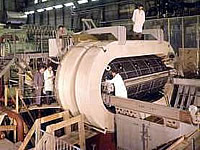
one of the first ones

one of the last ones
1952
Donald GLASER invented a bubble chamber.
The first bubble chambers were made of Pyrex glass and contained a few
cubic centimeters of liquid.
1959
Nobel Prize for Emilio SEGRE (US) and Owen CHAMBERLAIN (US), for demonstrating
the existence of the anti-proton. [more
details]
For a bubble chamber picture of a antiproton annihilation click
here.
1960
Nobel prize for Donald A. GLASER (US), for invention of "bubble chamber"
to study subatomic particles. [more details]
1968
Nobel prize for Luis Walter ALVAREZ (US)
He was awarded the 1968 Nobel Prize in Physics for his discovery of a
large number of resonance states (subatomic particles that have very short
lifetimes and that occur only in high-energy nuclear collisions), which
was made possible through his development of the liquid-hydrogen bubble
chamber. [more
details]
1969
Nobel prize for Murray GELL-MANN (US), for study of subatomic particles.
In 1961 GELL-MANN and Israeli physicist Yuval NE'EMAN independently introduced
the "eightfold way," or SU(3) symmetry, a table like ordering
of all subatomic particles analogous to the ordering of the elements in
the periodic table. The 1964 discovery of the omega-minus particle (from
a bubble chamber picture), which filled a gap in this ordering, brought
the theory wide acceptance and led to GELL-MANN's being awarded the 1969
Nobel Prize for Physics. In 1963, GELL-MANN and American physicist George
ZWEIG independently postulated the existence of the quark, an even more
fundamental elementary particle with a fractional electric charge. Quarks
are confined in protons, neutrons, and other particles. [more
details]
1973
Neutral currents were discovered at CERN in 25 ton Gargamelle bubble chamber.
For a bubble chamber picture of the first neutral current event click
here.
1974
7-foot Brookhaven bubble chamber started to operate.
This was the first particle detector of its type in which the chamber
through which the particles passed was surrounded by a superconducting
magnet. The following year, the 7-foot chamber was used to discover the
charmed baryon, a particle composed of three quarks, one of which was
the "charmed" quark. This result helped physicists confirm a
new member of the quark family.